Effect of the Conductive Carbon Content on the Resistance of Different Levels of the Battery
As a widely used new energy system, lithium-ion battery has a wide range of application prospects in mobile phones, computers, automobiles, energy storage and other fields. In recent years, due to the increasing requirements for fast charging performance in various fields, improving the multiplier performance of batteries has become the direction of lithium battery researchers and continuous exploration. Lithium-ion battery is composed of positive and negative electrode, diaphragm, electrolyte, when battery charging, lithium-ion from the positive, in the support of the electrolyte environment, through the diaphragm embedded in the anode, and battery ratio performance is related to the resistance of the whole lithium-ion migration process, to find a right way to reduce the resistance of each link need research personnel diligently to explore.
Conductive agent for lithium-ion battery ratio performance has played a key role, there are a lot of related studies show that it can improve the electronic transmission path, speed up the charge transmission, improve battery performance, but conductive agent due to particle size and density is less than the active material, how to ensure that it in the slurry and polar layer dispersed evenly, is also the focus of the battery ratio[1-6]. Through the change of the content of conductive carbon, from powder, slurry, pole and buckle battery four layers characterize the change of resistance performance, qualitative analysis of the influence of conductive carbon resistance, at the same time to explore the most suitable conductive carbon content on the electrical performance, for battery process and formula developers to provide favorable technical method support.
1.Experimental Materials and Methods
1.1 Materials
Nickel-Cobalt-manganese ternary material (NCM), Conductive carbon (SP), polyvinylidene fluoride (PVDF), N-methylpartner (NMP), Type 2032 buckle battery.
1.2 Analysis and Test Instrument
Four probe powder resistor (PRCD2100-IEST), four probe mode, slurry resistor (BSR2300-IEST), pole sheet resistor (BER2500-IEST), the above three equipment are from Yuan Energy Technology (Xiamen) Co., Ltd.; Battery Tester (CT-4008T-Neware), Electrochemical Workstation (DH7001).
1.3 Experimental Methods
According to the formula ratio shown in Table 1, five groups of cathode paste, electrode sheet and buckle batteries were prepared. Different test equipment were used to test the resistance performance of slurry, pole sheet and buckle batteries respectively, and then the influence of conductive carbon content change on the electrical performance of each level was analyzed.
Table 1 Percentage of Mass of the Five Sample Groups
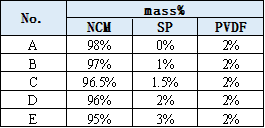
1.4 Sample Preparation
Call the materials according to the proportion of each group of materials in Table 1, mix the high-speed mixing defoam machine for 11 minutes, and some use the semi-automatic comachine to apply them to the aluminum foil. After drying, some of the pole parts, the pole half is used for the assembly of buckle battery. The buckle battery is assembled in an argon glove box, with the ternary pole sheet positive and the lithium sheet negative.
2.Experimental Results and Discussion
2.1 Analysis of Powder Layer
The powder resistivity of the used ternary materials and conductive carbon was tested respectively. Figure 1 shows that with the increase of the test pressure, the compaction density of ternary materials and conductive carbon gradually increases, while the resistivity gradually decreases, when the compaction density of ternary materials is 3.5 g / cm3.02 At that time, the resistivity is about 16.7 Ω * cm, and when the compaction density of the conductive carbon material is 1.0 g/cm3, the resistivity is about 0 * cm. Therefore, in the powder level, the ternary material resistance is 835 times that of the conductive carbon, and the conductive carbon conductivity is much better than that of the ternary material, which will affect the conductivity of the subsequent slurry and electrode.
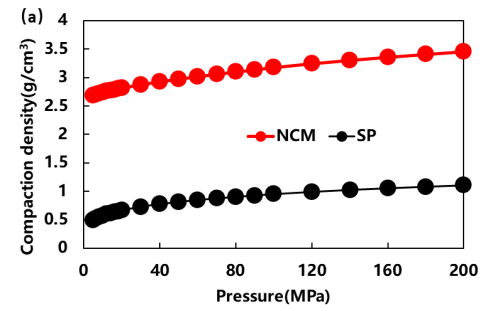 | 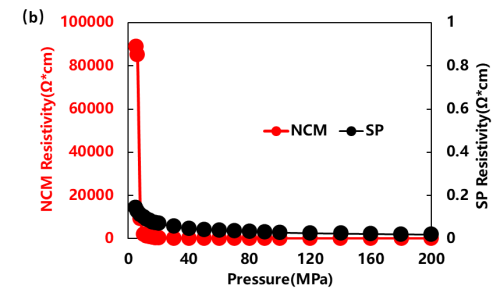 |
Figure 1: (a) Plot of powder compaction density change with test pressure intensity; and (b) Plot of powder resistivity change with compaction density
2.2 Analysis of the Layered Resistivity Performance of the Slurry and the Pole Sheet
Figure 2 (a) for the test results of five groups of slurry resistivity, as can be seen from the figure, the slurry resistivity is reduced with the increase of conductive carbon content, this is because when the conductive carbon content increases, in the slurry suspension of ternary particles between more conductive carbon particles connection, so the electron transmission between the particles is faster, the resistivity is smaller.Figure 2 (b) shows the test results of the electrode resistivity before and after the five sets of roller pressure. It can be seen from the figure that the electrode resistivity decreases with the increase of the conductive carbon content, which shows that the increase of the conductive carbon content will significantly improve the electronic conductivity between the particles. In addition, due to the closer contact between the particles and the coating layer and the fluid collector after the roller pressure, the resistivity value of the electrode plate is one order of magnitude lower than that before the roller pressure, which also indicates that the roller pressure will significantly improve the electrical conductivity of the positive electrode plate.
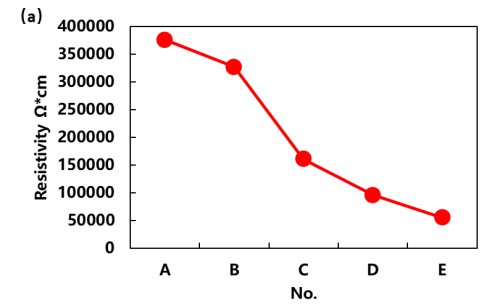 | 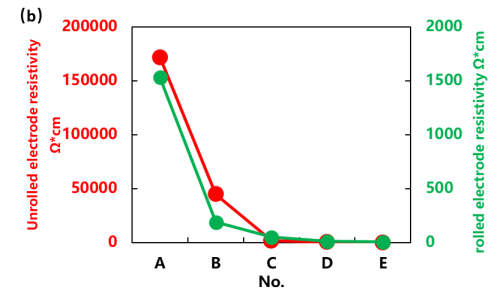 |
Figure 2: (a) resistivity curve of five slurry groups; and (b) resistivity curve of five pole groups
2.3 Resistance Performance Analysis of Buckle Battery
The AC impedance spectroscopy test and multiplier performance test of the five groups of buckle batteries after charging and discharging one activation were conducted, and the results are shown in Figure 3 (a), 3 (b) and 3 (c). In lithium-ion battery systems, the medium to high frequency range in the impedance spectrum represents electron transfer and charge transfer, and the low frequency range represents ion diffusion[7]. As can be seen from Figure 3 (b), with the increase of the battery transfer carbon content from 0% to 3%, the sum of the electron transfer Rs and the charge transfer resistance R ct also gradually decreases, which shows that the amount of conductive carbon added has a significant positive effect on the improvement of the battery resistance. In addition, if only the electronic resistance at the high frequency is compared, it will be affected by the contact resistance of the buckle battery shell and the pole plate, and the change trend of the first two groups is not consistent with the change of the conductive carbon content. According to the different ratio discharge capacity retention rate in Figure 3 (c), as the discharge ratio gradually increases to 2.5 C, when the conductive carbon content is less than 1%, the discharge capacity is almost less than 2%, while when the conductive carbon content is more than 1.5%, the discharge capacity of the battery remains above 80%. Therefore, the appropriate content of conductive carbon can significantly improve the battery multiplier performance.
 |  |
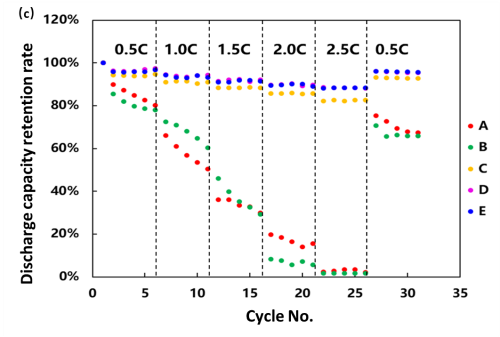
Figure 3 (a) E IS curve of five-group cells; (b) electronic resistance and ionic resistance curve of five-group cells; (c) different multiplier discharge retention ratio curve of five-group cells;
3. Conclusion
This paper from powder, slurry, pole and buckle battery four layers, respectively of five groups of different conductive carbon content samples resistance performance quantitative analysis, found that the added conductive carbon after good electrical conductivity than ternary material, slurry, pole, buckle battery conductance performance have a certain degree of improvement, and the appropriate content of conductive carbon can significantly improve the multiplier performance of the battery. The research in this paper reminds battery-related researchers that they can evaluate the electrical performance from different levels and pay attention to the impact of the appropriate conductive carbon content on the multiplier performance of batteries.
Reference Documentation
[1] Xu Jieru, Li Hong, et al. Test and analysis method of electrical conductivity in lithium battery research [J]. Energy Storage Science and Technology, 2018,7 (5): 926-955.
[2] Kondo H, Sawada H, Okuda C, et al.Influence of the active material on the electronic conductivity of the positive electrode in lithium-ion batteries [J].Journal of the Electrochemical Society, 2019, 166(8): A1285-A1290.
[3] Nie Lei, Qin Xing, Zhang Na, et al. Research on Lithium-ion Battery [J]. Power supply technology, 2019,43 (4): 562-563.
[4] Westphal B G, Mainusch N, Meyer C, et al.Influence of high intensive dry mixing and calendering on relative electrode resistivity determined via an advanced two point approach [J].Journal of Energy Storage, 2017, 11:76-85.
[5] Mainusch N, Christ T, Siedenburg T, et al.New Contact Probe and Method to Measure Electrical Resistances in Battery Electrodes [J].Energy Technology, 2016, 4, 1550-1557
[6] Liao Xiaodong, Huang Ju, Wang Ronggui. Effect of cathode conductive carbon content on the performance of lithium-ion batteries [J]. Dongfang Electric Review, 2013,27 (105): 4-7.
[7] Zhuang Quanchao, Xu Shoudong, Qiu Xiangyun, et al. Electrochemical impedance spectrometry analysis of lithium-ion batteries [J]. Chemical Advances, 2010,22 (6): 1044-1057.
